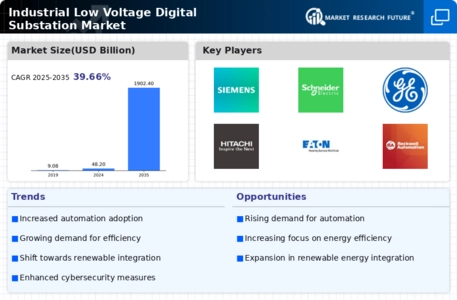Rising Demand for Energy Efficiency
The Industrial Low Voltage Digital Substation Market is experiencing a notable increase in demand for energy-efficient solutions. As industries strive to reduce operational costs and minimize their carbon footprint, the adoption of digital substations becomes more appealing. These substations utilize advanced technologies to optimize energy consumption, which can lead to savings of up to 30% in energy costs. Furthermore, regulatory frameworks are increasingly favoring energy-efficient practices, pushing industries to invest in modern infrastructure. This trend is likely to continue, as companies recognize the long-term benefits of energy efficiency, thereby driving growth in the Industrial Low Voltage Digital Substation Market.
Enhanced Data Analytics Capabilities
The rise of data analytics is transforming the Industrial Low Voltage Digital Substation Market. With the integration of Internet of Things (IoT) technologies, digital substations can collect and analyze vast amounts of data in real-time. This capability allows for improved decision-making, predictive maintenance, and enhanced operational efficiency. Industries are increasingly recognizing the value of data-driven insights, which can lead to reduced downtime and optimized performance. The market for data analytics in the energy sector is expected to grow significantly, indicating a strong trend towards leveraging data for operational improvements. This evolution is likely to further propel the Industrial Low Voltage Digital Substation Market.
Increased Focus on Automation and Control
Automation and control technologies are becoming integral to the Industrial Low Voltage Digital Substation Market. The need for real-time monitoring and management of electrical systems is prompting industries to adopt digital substations that offer enhanced control capabilities. These systems can facilitate remote operations, predictive maintenance, and improved fault detection, which are essential for maintaining operational efficiency. According to recent data, the automation segment within the electrical infrastructure market is projected to grow at a compound annual growth rate of 8% over the next five years. This growth indicates a strong inclination towards automated solutions, further propelling the Industrial Low Voltage Digital Substation Market.
Regulatory Compliance and Safety Standards
Regulatory compliance and safety standards are increasingly shaping the Industrial Low Voltage Digital Substation Market. Governments and regulatory bodies are implementing stringent safety regulations to ensure the reliability and security of electrical systems. Digital substations, equipped with advanced monitoring and control technologies, can help industries meet these compliance requirements more effectively. The market for electrical safety equipment is projected to grow significantly, driven by the need for compliance with these regulations. This trend underscores the importance of investing in modern digital substations, as they not only enhance safety but also ensure adherence to evolving regulatory frameworks, thereby boosting the Industrial Low Voltage Digital Substation Market.
Growing Investment in Renewable Energy Sources
The transition towards renewable energy sources is significantly influencing the Industrial Low Voltage Digital Substation Market. As countries and corporations invest heavily in solar, wind, and other renewable technologies, the need for efficient energy distribution systems becomes paramount. Digital substations are well-suited to integrate with renewable energy sources, allowing for better management of variable energy inputs. Reports suggest that investments in renewable energy are expected to reach trillions of dollars in the coming decade, which will likely necessitate the modernization of existing electrical infrastructure. This shift presents a substantial opportunity for the Industrial Low Voltage Digital Substation Market.

















Leave a Comment